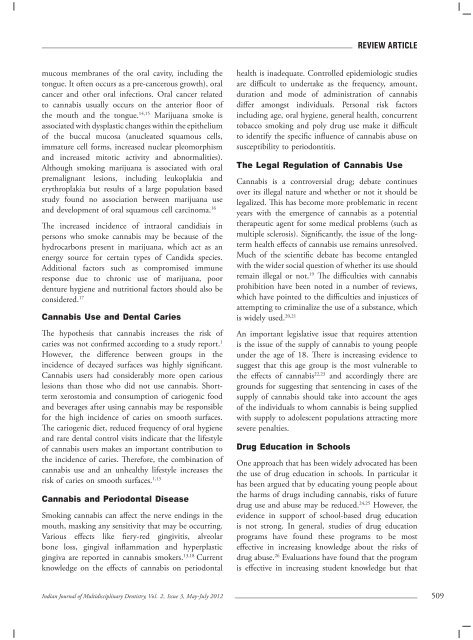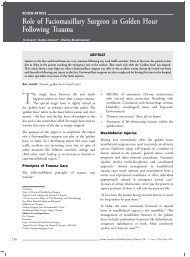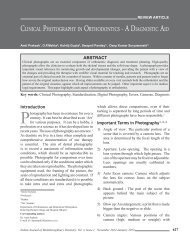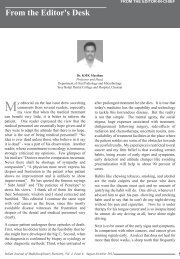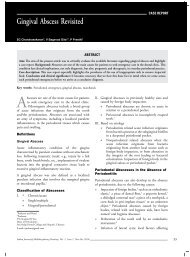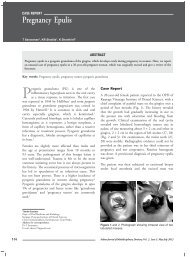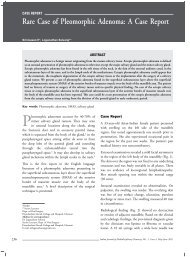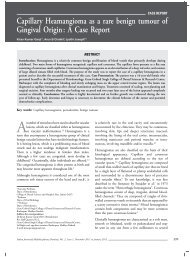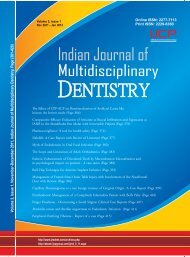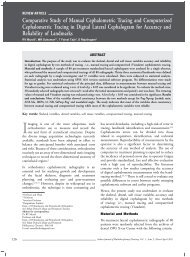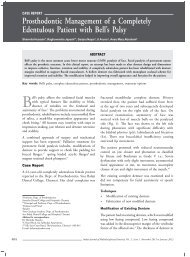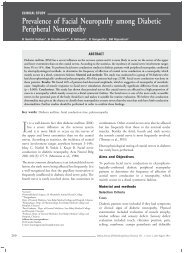Volume 2 - Issue 3 (May-Jul)
Volume 2 - Issue 3 (May-Jul)
Volume 2 - Issue 3 (May-Jul)
Create successful ePaper yourself
Turn your PDF publications into a flip-book with our unique Google optimized e-Paper software.
Review Article<br />
mucous membranes of the oral cavity, including the<br />
tongue. It often occurs as a pre-cancerous growth), oral<br />
cancer and other oral infections. Oral cancer related<br />
to cannabis usually occurs on the anterior floor of<br />
the mouth and the tongue. 14,15 Marijuana smoke is<br />
associated with dysplastic changes within the epithelium<br />
of the buccal mucosa (anucleated squamous cells,<br />
immature cell forms, increased nuclear pleomorphism<br />
and increased mitotic activity and abnormalities).<br />
Although smoking marijuana is associated with oral<br />
premalignant lesions, including leukoplakia and<br />
erythroplakia but results of a large population based<br />
study found no association between marijuana use<br />
and development of oral squamous cell carcinoma. 16<br />
The increased incidence of intraoral candidiais in<br />
persons who smoke cannabis may be because of the<br />
hydrocarbons present in marijuana, which act as an<br />
energy source for certain types of Candida species.<br />
Additional factors such as compromised immune<br />
response due to chronic use of marijuana, poor<br />
denture hygiene and nutritional factors should also be<br />
considered. 17<br />
Cannabis Use and Dental Caries<br />
The hypothesis that cannabis increases the risk of<br />
caries was not confirmed according to a study report. 1<br />
However, the difference between groups in the<br />
incidence of decayed surfaces was highly significant.<br />
Cannabis users had considerably more open carious<br />
lesions than those who did not use cannabis. Shortterm<br />
xerostomia and consumption of cariogenic food<br />
and beverages after using cannabis may be responsible<br />
for the high incidence of caries on smooth surfaces.<br />
The cariogenic diet, reduced frequency of oral hygiene<br />
and rare dental control visits indicate that the lifestyle<br />
of cannabis users makes an important contribution to<br />
the incidence of caries. Therefore, the combination of<br />
cannabis use and an unhealthy lifestyle increases the<br />
risk of caries on smooth surfaces. 1,13<br />
Cannabis and Periodontal Disease<br />
Smoking cannabis can affect the nerve endings in the<br />
mouth, masking any sensitivity that may be occurring.<br />
Various effects like fiery-red gingivitis, alveolar<br />
bone loss, gingival inflammation and hyperplastic<br />
gingiva are reported in cannabis smokers. 13,18 Current<br />
knowledge on the effects of cannabis on periodontal<br />
health is inadequate. Controlled epidemiologic studies<br />
are difficult to undertake as the frequency, amount,<br />
duration and mode of administration of cannabis<br />
differ amongst individuals. Personal risk factors<br />
including age, oral hygiene, general health, concurrent<br />
tobacco smoking and poly drug use make it difficult<br />
to identify the specific influence of cannabis abuse on<br />
susceptibility to periodontitis.<br />
The Legal Regulation of Cannabis Use<br />
Cannabis is a controversial drug; debate continues<br />
over its illegal nature and whether or not it should be<br />
legalized. This has become more problematic in recent<br />
years with the emergence of cannabis as a potential<br />
therapeutic agent for some medical problems (such as<br />
multiple sclerosis). Significantly, the issue of the longterm<br />
health effects of cannabis use remains unresolved.<br />
Much of the scientific debate has become entangled<br />
with the wider social question of whether its use should<br />
remain illegal or not. 19 The difficulties with cannabis<br />
prohibition have been noted in a number of reviews,<br />
which have pointed to the difficulties and injustices of<br />
attempting to criminalize the use of a substance, which<br />
is widely used. 20,21<br />
An important legislative issue that requires attention<br />
is the issue of the supply of cannabis to young people<br />
under the age of 18. There is increasing evidence to<br />
suggest that this age group is the most vulnerable to<br />
the effects of cannabis 22,23 and accordingly there are<br />
grounds for suggesting that sentencing in cases of the<br />
supply of cannabis should take into account the ages<br />
of the individuals to whom cannabis is being supplied<br />
with supply to adolescent populations attracting more<br />
severe penalties.<br />
Drug Education in Schools<br />
One approach that has been widely advocated has been<br />
the use of drug education in schools. In particular it<br />
has been argued that by educating young people about<br />
the harms of drugs including cannabis, risks of future<br />
drug use and abuse may be reduced. 24,25 However, the<br />
evidence in support of school-based drug education<br />
is not strong. In general, studies of drug education<br />
programs have found these programs to be most<br />
effective in increasing knowledge about the risks of<br />
drug abuse. 26 Evaluations have found that the program<br />
is effective in increasing student knowledge but that<br />
Indian Journal of Multidisciplinary Dentistry, Vol. 2, <strong>Issue</strong> 3, <strong>May</strong>-<strong>Jul</strong>y 2012<br />
509


